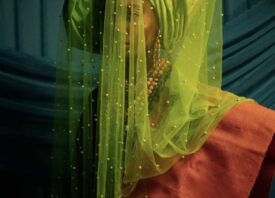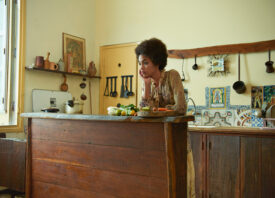Search this site
A Photographer’s Visual Diary Explores Sorrow, Trauma, Identity

Oliver Raschka studied and holds a doctorate in the field of behavioral economics. This helps him to capture the dynamics and specifics of social relationships
in his photography. For many years, the photographic autodidact has been dealing with the subject of family and the search for his own identity in documentary format. He lives with his family in Stuttgart (Germany). His second book Tween was published in 2023 via BUMMBUMM Books.
Tell me about this project and your process of curating this “archive work”. As you’re going through your archive, what are you looking for? What questions do you ask yourself during this process?
“In Sorrow Is All The Pain Of Love, I keep a kind of photographic diary exploring the unintentional and unconscious documentation of states of mind and how personal traumas of drastic family events, serious illnesses, and profound burnout manifest visually. The work itself deals with the personal sorrow of loss and pain in the search for identity.
“All photographs are from the archive (2010-2024). By using photographs that I took unintentionally and unconsciously, I gain authentic and deep access to what really concerns me.
“My family history is characterized by love but also by the loss of my mother, drastic family upheavals, addiction issues, and communication disorders. The essay reveals how negative and depressive feelings can transform into photographs in order to process these feelings.
“For me, creating the archival project supports healing and strengthens mindfulness in a way of curiosity and self-confidence in the presence of severe events. Catharsis leads to self-acceptance, the unconditional acceptance of one’s own person with all their strengths and weaknesses and the endeavor to draw strength from difficult life circumstances.
“This is the project in a nutshell. But I hadn’t planned the work at all. Rather, it found me. Maybe over 25 years ago, when I took my first serious photograph. However, the timing, so that a project is now emerging and we can talk about it, is a coincidence.
“When I was completely confined to my home for several months in 2023/2024 due to the rupture of my Achilles tendon, I started to reorganize my photographic archive. Working on my laptop was one of the few things I could do while sitting or lying down.
“As I coped with this recent trauma and had to learn to walk again, I was particularly struck by photographs that I could never match to a specific project, but with which I associated strong feelings and memories of drastic and personal events.
“I went into resonance with the individual photographs and also searched through the original memory cards and negatives for further images.
“The years from 2010 to 2024 were a very intense time for me. The birth of my sons was followed by the unexpected death of my mother. Followed by brain haemorrhages, I was also accompanied by burnout. After that, I had to deal with the pandemic and isolation. In recent years, life has taken on new meanings in rapid succession.
“While working on this project, I came across existential questions about life by means of the photographs: Why do I take (unintentionally) particular photographs in moments of personal upheaval or extreme situations? What do the photographs want to reveal? How can I learn from visual disclosure and gain positive energy for difficult life situations that I want to face with ease and self-confidence?”

Can you share something you discovered about yourself when going through your archive in this way?
“Working with the archive confirmed what I had been feeling for some time, the fact that sorrow is “my theme”. Including all aspects of worry, grief, sadness and loss. Today I can see from the photographs what sorrow can look or feel like to me visually, what different facets and feelings it has.
“Over the years I have repeatedly taken spontaneous and unpretentious self-portraits. What I’ve noticed while working on Sorrow Is All The Pain Of Love is that in the early years, I took self-portraits that were like silhouettes; today, they are direct facial images. Behind this is a process of self-acceptance, of accepting oneself with all one’s strengths and weaknesses without reservation and of understanding that the whole of life is a journey.”
In your excellent interview with Too Tired Project, you say about this work, “I’m trying to find a deeper approach to mindful photography with this work in order to develop myself personally.” Can you expand on what you mean by “a deeper approach to mindful photography”? How is this project helping?”
“In general, I find the question of what photography can contribute to the individual and how it can support a mindful life and mental health exciting.
“I have discovered that by using photographs that I took unintentionally and unconsciously, I gain authentic and deep access to what really concerns me. If I understand what is really going on with me, I can take action so that I can deal with it and move forward. The photographs help me to visualize what touches and drives me. Beyond all rationality and attempts at suppression.
“The photographs reveal fundamental questions of social relationships of any kind: What do I have to burden myself with? What things from my family history do I want to face? Which problems have to do with me or are the problems of others? How can I use my deepest fears in a positive way for myself? How do I gain strength instead of falling into fear and rigidity?
“Sorrow Is All The Pain Of Love gives me the opportunity to initiate a constructive course of action and advances mental health through photography. The work supports the process of healing and strengthening mindfulness in a way of curiosity and self-confidence in the presence of past traumas and severe family events. For me, this a new and exciting approach to a kind of mindful photography. The aim is to derive constructive new courses of action from this awareness-raising process. The further development of the personality opens up a new level of relationship with loved ones and strengthens empathy, but communication with strangers also becomes more intense and personal. This releases a whole new strength of liberated life and deeper inner feelings.”

You’re concentrating on images from 2010-2024. Are you only revisiting times that were particularly difficult for you on a personal level? If not, how do you recall what you were going through when you took X image during the Summer of 2012?
“As this archive work takes a lot of time, I have started by limiting myself to the last 14 years. But the work is ongoing. So, I will review my whole archive, but at the same time I want the series to be coherent.
“I think that events in particular, such as a serious accident or death, remain in our consciousness forever. At the same time, the themes that resonate with them, such as the emotional and physical consequences or the relationship with a person, are prevalent throughout a long period of life. Looking at the archive inevitably brings these emotions back to mind and the memory of the personal situation at that time is there. Sometimes it is the little things in the photographs that point directly to this.”
You mention photographs of trees, landscapes, and self-portraits as the images that you used to help overcome trauma. Any thoughts as to why these three?
“No, not really.
“When I feel unwell or to gain clarity about my thoughts and feelings, I primarily look at nature for reflection and trees as a resonance board for growth and development. Since these photographs are taken spontaneously and without a plan based on the specific emotional state at that time, I only came across this behavioral pattern when I was looking through and processing the archive.
“In principle, trees and nature in general are a kind of life companions. I find the abstract idea that trees are contemporary witnesses to the events around them over decades, even centuries, and are therefore also contemporary witnesses to my own life and that this information is stored in them here on site, so to speak, fascinating. Perhaps I hope that the trees will give me feedback on my current situation or simply give me shelter and trust, as they are always there. The same applies to the portraits. Here, too, I try to use photography to confirm that I am “there” and that I really exist. A kind of proof. But that’s very philosophical now.”
Aside from photography, what other modalities do you use in your process of self-discovery/understanding?
“As a behavioral economist, my professional interest also lies in analyzing and reflecting on human behavior. This helps me to capture the dynamics and characteristics of social relationships and psychological states in my photography. However, when viewed in its entirety, photography is only one component. The triad of photography, music and literature is my source from which I gain strength and inspiration.
“At the same time, I am committed to personal development and continue my education in seminars and workshops. At the same time, the daily exchange with my wife, who is very active in the field of coaching, is central for me.”

What advice do you have for someone going through a rough patch that may not have an extensive archive to pull from? What tips do you have for photographers who are ready to walk out of their door now and photograph?
“Working with the archive is actually the phase of processing and further development. In that respect it doesn’t matter.
“If someone is currently in a difficult life situation, that person should make sure that taking photographs or feeling of having to capture something does not create more pressure or stress during this difficult phase. This can be very counterproductive.
“During the pandemic, long walks, which I did every day as a routine, helped me a lot. I always took photographs without any ulterior motives or concepts as to what the photograph might be good for. But I often didn’t take any photographs at all. I’ve also only been taking photographs with a small camera with a fixed focal length for years. This helps me to focus and get rid of any unnecessary ballast. It also strengthens your own visual language. You can then see which theme or concept you have based on the resulting images and not the other way round. Listen to the photographs!
“It doesn’t help to look at what’s currently trending on social media. Strong works are characterized by their own approach an imagery. It’s important to look at yourself.
“It’s the immediate and daily environment that shapes a person. This means that everyone has a very personal story that makes it unique to be told. Therefore, every photographic work basically offers a new story for everyone. The work thus allows others to reflect on their own life experiences and engage with themselves. This creates a new web of connections between us as humans. This opens up the opportunity to exchange ideas with one another, as we are doing here with the interview.
“The key is to identify what the specific personal theme could be, what makes it interesting to document it visually, what the person knows best about and can therefore portray it authentically. It can take a long time to identify the real underlying issue. My work has always been long-term projects spanning several years. But it is worth it. For yourself, because you grow from it, and for all viewers, because a new network is created.”


